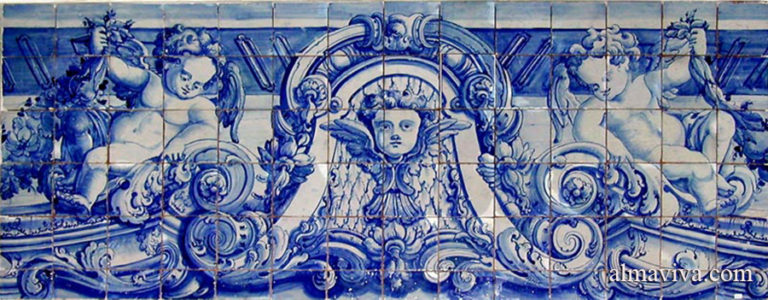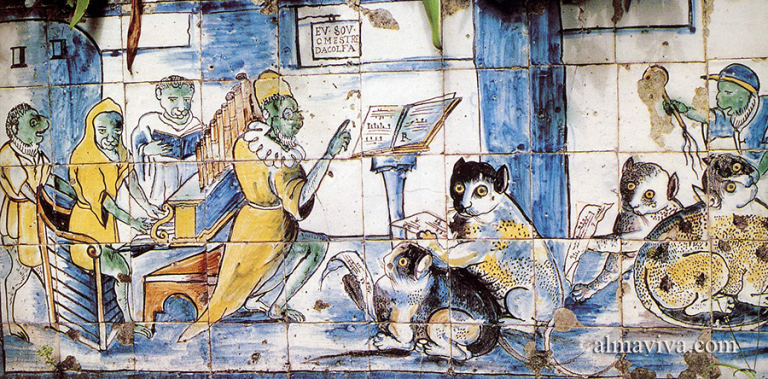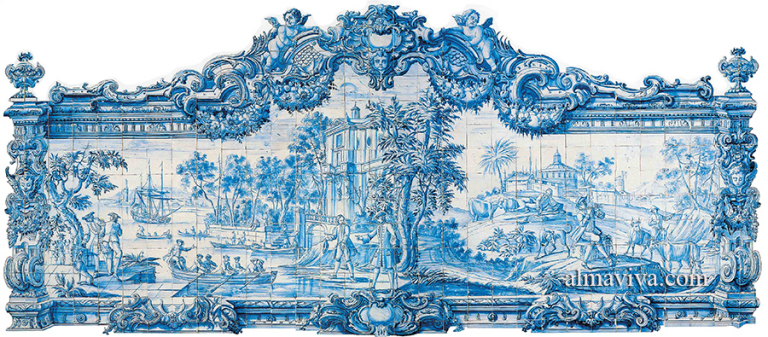Commissioning handmade azulejo tiles
IMAGE GALLERY: examples of our azulejos
The Paris-based Almaviva tile studio makes azulejo tiles with great respect of ceramic tradition.
We use only manual Renaissance techniques to produce tiles and tile panels. The clay is stamped by hand and decorations are hand painted with natural oxides.
We are artisans mainly commissioned tiles and murals by architects and home designers. We often work for restoration projects since our production closely resembles ancient tiles.
Over the years we have gathered a vast image library of ancient tiles and azulejo panels.
Our showroom is in the centre of Paris.
The azulejos: a Moorish art born in Spain
The word azulejo is derived from the Arabic word az-zulayj which means “little polished stone”. This origin shows the unmistakable Arab influence in tiles. The Moors occupied the Iberian peninsula between the 8th and the 15th century; they brought their ceramic techniques, including the opaque tin glaze. Originally, their idea was to reproduce the Greco-Roman mosaics with fragments of coloured tin-glazed tiles.
During the 12th century, tiles were cut in small pieces and assembled to create mosaics; they are known in Spain as alicatados. Later on were used cloisonné techniques known as cuerda seca (dry-string) and arista (edge). They made it possible to separate several colours on the the same tile. The city of Seville was the major centre of the Hispano-Moresque tile industry.
Wonderful examples of original Moorish tile-works can be admired in Spain in the Alhambra of Granada and the Alcazar of Seville, and in Portugal, in the Arab Room of the Sintra National Palace.

The Italian Renaissance in Seville
A revolution took place around 1500 under the influence of the Italian Renaissance. Then appeared the type of tiles that we usually picture nowadays as “azulejos”.
Francisco Niculoso was a painter of Italian tin-glazed pottery, known in Italy as “maiolica”. He came from Pisa and established himself in Seville in 1498. Seville tile studios had always produced tiles with geometric patterns under the Moorish influence. Niculoso started painting tiles like Italian maiolica, with smooth colour transitions. He moved from geometry to figuration with the representation of human characters, in particular religious scenes. He also introduced the so-called grotesque ornaments that had just appeared in Italy when the Domus Aurea, the palace of Nero, was excavated in Rome in the 1490s. Thanks to Niculoso tile and tile murals started depicting religious scenes, mythological characters, floral ornaments and bouquets. After Seville, these new style and techniques moved to several places such as Talavera de la Reina (province of Toledo), and the regions of Valencia and Barcelona.
Other Italians potters and maiolica painters moved to Antwerp in Flanders around 1500. Thanks to them, this new ceramic technique rapidly developed in northern Europ: Holland, England and France (see: www.delft.fr for the history of the Dutch tile).
The azulejos: a decorative art developed in Portugal
It is in Portugal that the use of tin-glazed tiles in architecture culminated. During the 17th and 18th century, palaces, churches and convents, public fountains, and complete façades were covered with tiles. Besides biblical scenes, tiles murals were depicting historical scenes such as royal weddings or famous battles, landscapes with monuments and characters, seascapes with boats, harbours and fishermen, elaborate bouquets, etc. As their Spanish predecessors, Portuguese azulejos were first polychromatic, with vivid colours. It is under the influence of blue and white Chinese porcelain that Portuguese azulejos became mostly blue and white in the early 18th century.
Ceramic tiles are still being used nowadays in Portugal. For many travellers, azulejo tiling is therefore one of the strongest elements of the Portuguese culture.




